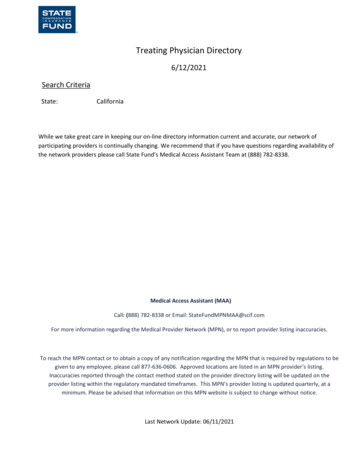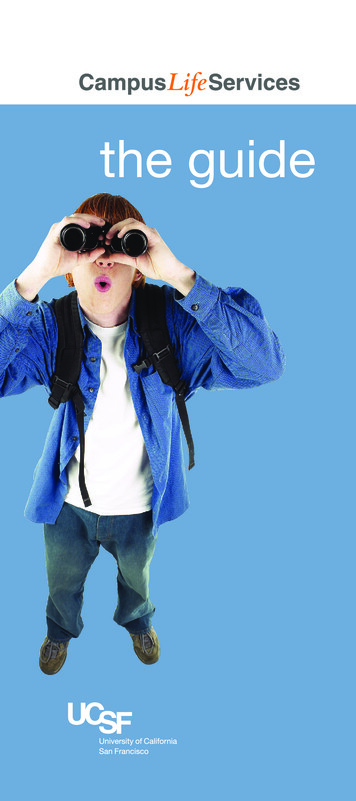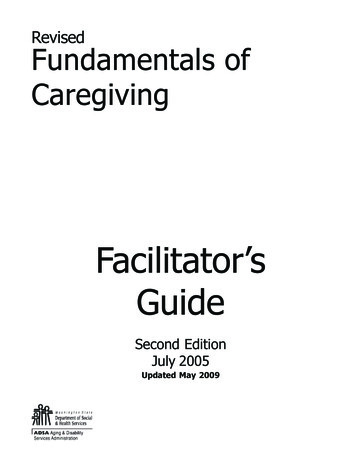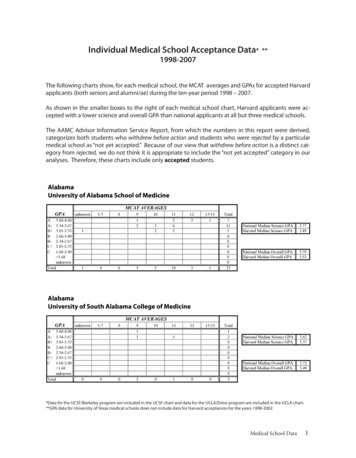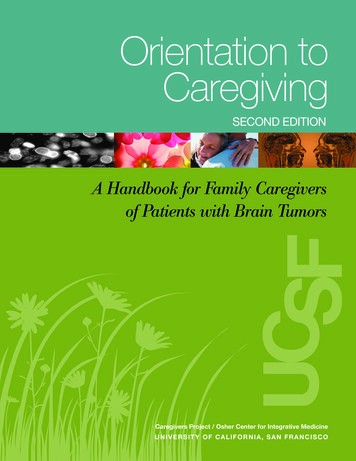
Transcription
Orientation toCaregivingSecond EditionA Handbook for Family Caregiversof Patients with Brain TumorsCaregivers Project / Osher Center for Integrative MedicineU n i v e r s i t y o f C a l i f o r n i a , S a n F r a n ci s co
Orientation to CaregivingA Handbook for Family Caregivers of Patients with Brain TumorsSteffanie Goodman, MPH1Michael Rabow, MD 2Susan Folkman, PhD1,2University of California, San Francisco1Osher Center for Integrative Medicine2Department of MedicineThis handbook is a product of the Caregivers Project, a collaboration between the UCSF Osher Center for IntegrativeMedicine and the UCSF Department of Neurological Surgery. The first edition, published in 2007, was funded bygenerous gifts from the Langeloth Foundation, the Mental Insight Foundation, and the Arthur Vining Davis Foundation.The second edition, published in 2013, was generously funded by the DemandHope Foundation.AcknowledgementsWe thank Susan Chang, MD; Margaretta Page MS, RN,Judy Patt Smoker, LCSW, Celi Adams, RN, and MitchelBerger, MD, Chair, UCSF Department of NeurologicalSurgery, for their careful reviews of this handbook. Weare grateful to the faculty and staff of UCSF Departmentsof Neurological Surgery and Neuro-Oncology, including:Marlene Burt, NP; Anne Fedoroff, RN; Anna Frankfurt,RN; CNRN; Kerri Keough, LCSW; Margaretta Page, MS,RN; and Jane E. Rabbitt, RN, BSN, for the informationthey provided for Chapters 3 and 4. We also gratefullyacknowledge the contributions of David Becker, MD;Meryl Botkin, PhD; J. Henry Glazer, JD; Francina LozadaNur, DDS, MS; Joelle Steefel, and many family andclinical caregivers who graciously gave their time andexpertise to this project. Without their personal accounts,careful review, and insightful commentary, this handbookwould not have been possible.Design by Laura Myers Design 2013 The Regents of the University of CaliforniaUCSF Neuro-OncologyGordon Murray Caregiver Program505 Parnassus Avenue, M-779San Francisco, CA 94143-0112Phone: 415-353-7500Fax: 415-353-2880Osher Center for Integrative MedicineUniversity of California, San Francisco1701 Divisadero Street, Suite 150San Francisco, CA 94115Mailing Address:Box 1726San Francisco, CA 94143-1726Phone: 415-353-7700Fax: 415-353-7711
ContentsChapter 1: A Handbook aboutWhat to Expect as a Family CaregiverHandbook Overview . . . . . . . . . . . . . . . . . . . . . . . . . . . . . . . . . . . . . . . . . . . . . . . . 1.2Importance of Family Caregiving . . . . . . . . . . . . . . . . . . . . . . . . . . . . . . . . . . . . . . 1.3Chapter 2: Managing Care at HomeIdentifying Critical Tasks . . . . . . . . . . . . . . . . . . . . . . . . . . . . . . . . . . . . . . . . . . . . . 2.2Accomplishing Caregiving Jobs . . . . . . . . . . . . . . . . . . . . . . . . . . . . . . . . . . . . . . . 2.3Doing the Job Yourself . . . . . . . . . . . . . . . . . . . . . . . . . . . . . . . . . . . . . . . . . . 2.3Getting Help from Friends and Family . . . . . . . . . . . . . . . . . . . . . . . . . . . . . . 2.4Paying for Help . . . . . . . . . . . . . . . . . . . . . . . . . . . . . . . . . . . . . . . . . . . . . . . . 2.5Getting Organized . . . . . . . . . . . . . . . . . . . . . . . . . . . . . . . . . . . . . . . . . . . . . . . . . . 2.6Managing Medications . . . . . . . . . . . . . . . . . . . . . . . . . . . . . . . . . . . . . . . . . . . . . . 2.7Tracking Treatments and Side Effects . . . . . . . . . . . . . . . . . . . . . . . . . . . . . . . . . . . 2.8Chapter 3: Symptoms Associated with Brain Tumorsand Side Effects of TreatmentCommon Brain Tumor Symptoms . . . . . . . . . . . . . . . . . . . . . . . . . . . . . . . . . . . . . . 3.2What to Do If Symptoms Occur . . . . . . . . . . . . . . . . . . . . . . . . . . . . . . . . . . . . . . . 3.3Identifying and Treating Psychological Symptoms . . . . . . . . . . . . . . . . . . . . . . . . . 3.6Symptoms Based on Tumor Location . . . . . . . . . . . . . . . . . . . . . . . . . . . . . . . . . . . 3.7Common Side Effects of Treatment . . . . . . . . . . . . . . . . . . . . . . . . . . . . . . . . . . . . 3.8Chapter 4: Tasks of Caregiving in the Hospital and ClinicA Multidisciplinary Medical Team . . . . . . . . . . . . . . . . . . . . . . . . . . . . . . . . . . . . . . 4.2The Hospital Team . . . . . . . . . . . . . . . . . . . . . . . . . . . . . . . . . . . . . . . . . . . . . 4.2Specialists . . . . . . . . . . . . . . . . . . . . . . . . . . . . . . . . . . . . . . . . . . . . . . . . . . . 4.3Rehabilitation Therapists . . . . . . . . . . . . . . . . . . . . . . . . . . . . . . . . . . . . . . . . 4.5Caregiving in the Hospital . . . . . . . . . . . . . . . . . . . . . . . . . . . . . . . . . . . . . . . . . . . . 4.6Hospital Admissions . . . . . . . . . . . . . . . . . . . . . . . . . . . . . . . . . . . . . . . . . . . . 4.6Medical Team Schedules . . . . . . . . . . . . . . . . . . . . . . . . . . . . . . . . . . . . . . . . 4.6What to Expect When Your Loved One Has Surgery . . . . . . . . . . . . . . . . . . . 4.6Preparing for Hospital Discharge . . . . . . . . . . . . . . . . . . . . . . . . . . . . . . . . . . 4.7Caregiving in the Clinic . . . . . . . . . . . . . . . . . . . . . . . . . . . . . . . . . . . . . . . . . . . . . . 4.8Preparing for a Doctor’s Visit . . . . . . . . . . . . . . . . . . . . . . . . . . . . . . . . . . . . . 4.8Communicating with the Medical Team . . . . . . . . . . . . . . . . . . . . . . . . . . . . . 4.8On the Day of the Visit . . . . . . . . . . . . . . . . . . . . . . . . . . . . . . . . . . . . . . . . . . 4.9What Are Clinical Trials? . . . . . . . . . . . . . . . . . . . . . . . . . . . . . . . . . . . . . . . . . 4.10Orientation to Caregiving
Chapter 5: Communicating with Childrenand Your Partner about IllnessHow to Speak with Your Children about Cancer . . . . . . . . . . . . . . . . . . . . . . . . . . 5.2Helpful Communication Techniques . . . . . . . . . . . . . . . . . . . . . . . . . . . . . . . . . . . . 5.3Communicating with Your Partner . . . . . . . . . . . . . . . . . . . . . . . . . . . . . . . . . . . . . 5.5Chapter 6: Paying for HealthcareWorking with the Insurance Company . . . . . . . . . . . . . . . . . . . . . . . . . . . . . . . . . . 6.2What to Do When Insurance Won’t Pay . . . . . . . . . . . . . . . . . . . . . . . . . . . . . . . . . 6.3Appealing a Decision . . . . . . . . . . . . . . . . . . . . . . . . . . . . . . . . . . . . . . . . . . . 6.3Professionals Who Can Help . . . . . . . . . . . . . . . . . . . . . . . . . . . . . . . . . . . . . 6.3Options for Financial Assistance . . . . . . . . . . . . . . . . . . . . . . . . . . . . . . . . . . 6.4Chapter 7: Planning for the FutureAdvance Care Planning . . . . . . . . . . . . . . . . . . . . . . . . . . . . . . . . . . . . . . . . . . . . . . 7.2Personal Business . . . . . . . . . . . . . . . . . . . . . . . . . . . . . . . . . . . . . . . . . . . . . . . . . 7.4Estate Planning . . . . . . . . . . . . . . . . . . . . . . . . . . . . . . . . . . . . . . . . . . . . . . . . . . . 7.5Chapter 8: Caring for the Caregiver:Maintaining Physical Health and Well-beingSelf-Care Strategies . . . . . . . . . . . . . . . . . . . . . . . . . . . . . . . . . . . . . . . . . . . . . . . . 8.2Focus on What Matters . . . . . . . . . . . . . . . . . . . . . . . . . . . . . . . . . . . . . . . . . . . . . . 8.3Realign Your Personal Goals . . . . . . . . . . . . . . . . . . . . . . . . . . . . . . . . . . . . . . . . . 8.3Benefit Finding and Benefit Reminding . . . . . . . . . . . . . . . . . . . . . . . . . . . . . . . . . . 8.4Infuse Ordinary Events with Meaning . . . . . . . . . . . . . . . . . . . . . . . . . . . . . . . . . . . 8.5Allow Yourself to Laugh . . . . . . . . . . . . . . . . . . . . . . . . . . . . . . . . . . . . . . . . . . . . . . 8.5AppendixCalendar Templates:Information Sheets:l WeeklylPain Rating ScalelMonthlyl HomelMonthly / WeeklylHow to Communicate Your LovedOne’s Symptoms Regarding OverallWelbeing, Pain, etc.lHow to Communicate Your LovedOne’s Symptoms During a CrisislHow to Communicate withInsurance Company PersonnelForms and Checklists:l Caregivingl TreatmentChecklistLoglMedication LoglHealth History FormlPersonal Care Team MemberInformation FormHealthcare Primerl CancerOrientation to Caregivingand Caregiving Resources
Chapter 1A Handbook aboutWhat to Expect as aFamily CaregiverThere is no work more important, more challenging ormore meaningful than caring for a loved one who is ill.About one-quarter of Americans will serve as caregiversto a beloved family member or friend.Family caregivers quickly become experts atthis demanding job but often feel like they have to“re-invent the wheel” in figuring out and prioritizing themany tasks involved.This handbook has been developed to provideeasily accessible and accurate information tofamily caregivers helping to care for loved oneswith brain tumors.Orientation to CaregivingChapter 1 / Page 1.1
Handbook OverviewWhile much of this handbook providesThe handbook is organized into eightchapters with multiple resources andappendices at the end.general information, it has beenprepared specifically for familylhandbook.caregivers of patients in the Neurosurgery andNeurological Oncology practices at the Universitylof California, San Francisco. All the contentsChapter 1 provides an overview of theChapter 2 focuses on routine familycaregiving at home, including tips to help youmanage medications and medical recordsand coordinate a care team.presented here have been carefully reviewedby Dr. Mitchel Berger, the Chairman of theDepartment of Neurological Surgery at UCSFand an international expert in the treatment oflbeen developed and reviewed in consultationwith Celi Adams, RN, who founded Home CarelCompanions and Caregiving 101, nationallyChapter 4 talks about the critical role offamily caregivers at the doctor’s officeand in the hospital and gives you helpfulcommunication advice when speaking withyour medical team.recognized family caregiver supportorganizations. Much of the content has beenadapted from resources currently available on theInternet and from family caregiving organizations.At the back of the book we have noted the sourceChapter 3 outlines common brain cancersymptoms, treatment side effects and offersdirection about whom to call for help and when.brain tumors. In addition, this information haslChapter 5 provides helpful tips forcommunicating with your family.of all borrowed material and appreciate thepermissions we have received to present it here.lThe handbook covers thefull range of issues faced byfamily caregivers, includingmanaging physical symptoms,caring for your loved one athome and in medical facilities,communicating with healthcareproviders, managing emotionaldistress, supporting thecaregiver, and handlingfinancial and legal issues.Chapter 6 reviews the different types ofhealth insurance, entitlements, and assistancethat may be available to help you pay forhealth care and discusses how you can be aneffective advocate for your loved one.lChapter 7 advises you on important plansyou should make to secure quality end-of-lifemedical care, and estate planning.lChapter 8 suggests strategies to maintainyour own well-being and to give you a senseof control, hope, and balance.lThe AppendiX include a series of resourcesand more detailed information that you canturn to.Orientation to CaregivingChapter 1 / Page 1.2
Importance ofFamily CaregivingCwith a serious illness, combined with the burdenof caregiving, can create strain in the relationshipand stress for you. At some points you may feeloverwhelmed, guilty, resentful, angry, anxious,aring for loved ones with brain tumorsmeans that you are dealing with medicaland even depressed1. These varied and complexissues at the same time that you alsoemotions are common. It is normal to feelare serving as a source of important emotionalboth positive and negative emotions whensupport for the person facing cancer. As a familyproviding care for a loved one who is ill.Sometimes circumstances thrust people intocaregiver, you are called upon to perform a largevariety of tasks to provide care for your lovedthe role of caring for someone, often a relative,one. For example, family caregivers:with whom they may have a strained relationship.This situation can intensify the usual negativelOrganize and administer medicationslCommunicate with physicians, nurses, andsocial workersresentment. Under these circumstances it islProvide transportationhands-on care and for emotional support.lTake care of home chores including cookingand cleaninglHelp with dressing changeslAssist with physical therapy and occupationaltherapy exercisesthe frustration and sense of isolation you may feelResearch and negotiate medical insurancebenefits and submit claimsimpossible job. The handbook provides tips onlemotions caregivers feel, especially guilt andimportant to seek help both for the actualWhile no amount of information can eliminatethe physical work and emotional challenges ofcaring for a loved one who is ill, the helpful hintspresented in this handbook are designed to easewhile doing what can sometimes seem like anwhich situations call for professional help, so youlAttend to business, legal, and financial matterslMonitor medication side effectswill have a better sense of what you can expect,when to call the doctor, and what you can do athome to help.For most family caregivers, responsibilities atYou are an instrumental partof your loved one’s health careteam. Our deepest respect goesto you for the assistance yougraciously and lovingly offer.work and home do not stop when a loved onegets ill. Your own personal needs for rest andattention to your own health do not go awayeither. This means that you may find yourselfjuggling multiple responsibilities, some of whichmay conflict.Caring for a loved one who is ill often createsa deepened sense of closeness and connectionbetween the two of you. You may experienceincreased intimacy, satisfaction, and pride.However, the anxiety that comes with dealing1Gauthier A, Vignola A, Calvo A, Cavallo E, Moglia C, Sellitti L, Mutani R,Chio A: A longitudinal study on quality of life and depression inALS patient-caregiver couples. Neurology. 68(12):923-6, 2007.Orientation to CaregivingChapter 1 / Page 1.3
Chapter 2In this chapter:lIdentifying TaskslAccomplishingCaregiving JobslTips for FindingHome Care Servicesl GettingOrganizedManaging Careat HomeBecoming the primary caregiver for a loved one can bea real challenge. You must learn to balance work, family,and your own needs, while caring for someone else andlManaging Medicationsfulfilling some of the responsibilities he or she used tolTracking Treatmentsand Side Effectshave. Caregiving requires skills that you maynot be familiar with and demands the ability tomanage your loved one’s care almost as if it werea complex business project. This chapter providesan overview of the different tasks involved in caregivingat home and features an important discussion aboutorganizing medical records, tracking treatments, andmanaging medications — some of the most critical jobsof a caregiver. Finally, it offers some guidance abouthow to prioritize your caregiving responsibilities, andoffers tools to organize supportive family members andfriends who may be able to help.Orientation to CaregivingChapter 2 / Page 2.1
Routine TasksIdentifyingCritical TasksSome caregiving tasks aresimple and basic, involvinghousehold chores andFood PreparationlPlan, prepare, and serve mealslBuy groceriesl CleankitchenManagerial Tasksmaintenance, while others arelManage finances, banking, and billsmore private and involve hands-onlApply for social services and financial assistancepatient care. Talk to your lovedlManage insuranceone about the tasks that need tolAttend to legal matters (examples: Advance Health Directives,Powers of Attorney)lManage medical appointmentsbe accomplished and involve himor her in doing tasks wheneverpossible. Also, consider how muchwork it will take to accomplishTransportationeach task—is it a one-time task orlDrive/assist with transportation to appointments and recreationan ongoing need?lGet disabled parking placard from DMVlRun errands123Identify tasks that areroutine and tasks that involvehands-on patient careMake a list of what tasksneed to be accomplishedand maintainedEstimate the hours per day,week, or month that taskswill requireAssuming a Loved One’s Prior ResponsibilitieslCare for pets, children, and elderly/other family membersHouseworklLaundrylGarbage removallHouse and yard maintenanceTasks Involving Hands-on Patient CareIn-home SupervisionYou may need to become familiarlProviding companionshipwith tasks that are new for you, butlProviding safety and comfort at homeare common for home care. We’vePersonal Hygieneorganized them in the chart at right.lBathingl OrallhygieneSkin and hair careMedical/Nursing CarelManaging and administering medicationsl Liftingand transferring in and out of beds and chairsRecreationlRecreation and respite activities with familyOrientation to CaregivingChapter 2 / Page 2.2
Accomplishing Caregiving JobsAs your loved one’s illness changes or progresses, responsibilities for care may change as well.You may find that you can only take on a limited number of responsibilities while you balanceyour life. As a primary caregiver, you may have the option of caring for your loved one yourself,coordinating a team of volunteer caregivers to help you, or hiring outside help from various organizations.1Doing the job yourselfIf you will be doing the actual caregiving work,lExplore your benefits. Your employermay provide you with paid or unpaid medicalleave for family caregiving. Discuss yourbenefits with your supervisor or humanresources representative. If your loved onequalifies as low income, you may be eligible toreceive financial assistance for care, or yourloved one may be able to receive attendantcare through in-home support services.lLearn caregiving skills. There are manyorganizations that offer one-day workshopsand evening classes to teach caregiving skills.Find options by looking online or contactinglocal social service agencies that provideassistance to people with brain tumors, canceror other disabilities. Consult a social workeror use the Yellow Pages to find help.use these tips to help adjust to the role:Importantnot ImportanturgentPrioritize your time and responsibilities.Schedule your priorities. Determine which tasksin your life are urgent, which are important,which are both, and which are neither.This allows you to focus only on the necessarytasks to maintain your home and life.DoConsidernot urgentlScheduleDon’t doAdapted from First Things First, (1994) Covey, Merrill & Merrill 1Orientation to CaregivingChapter 2 / Page 2.3
2Getting Help from Friends and FamilyBring family members and friendsIdentifying Your Caregiving Teamtogether and request their help inl Askcaregiving. This may not be easy foryou. You might find it difficult to askfor help because it feels like anadmission that you can’t handlewhat you need to do or because youfeel you are imposing on others.Even if people do offer help, it canbe difficult to accept.It is important to get beyond thesebarriers because there are timesyour loved one and other family members who would beappropriate helpers.l Explore your loved one’s or your family’s phone book orRolodex for social contacts.l Contact your loved one’s or your family’s social organizationssuch as religious organizations, workplace, and socialgroups/clubs.l Find professional home-care organizations through theInternet, local newspapers, and the phonebook.l Consider people’s skills, abilities to manage time andprojects, and strengths and weaknesses.when you simply can’t and shouldn’tOnce you have put together a care team, you’ll need todo it all yourself. It may help tocoordinate the members so that everyone’s efforts are usedrealize that most family membersmost effectively. Here are some suggestions.and friends appreciate havingthe opportunity to be helpful.At the same time, it is important toCoordinate the Carel Youor a family member (not your loved one) should call toinvite the person to help.be sensitive to signs that volunteersare wearing out, in which case newones need to be found. Sometimes,lHold an introductory one-hour meeting for all team membersto discuss the specifics:the “retiring” volunteers can helplissues regarding the illness and patient’s needsreplace themselves.lwhat the current needs are of the patient and familyCreating a Care Team will addlthe roles or tasks each member can takesupport for your loved one and forlcontact informationyou. If you choose to create a teamlteam members’ schedules, availabilities, tasks they’rewilling to doldelegation of a “team leader” to make phone calls to teammembers during emergencies, when there is a change inplans, or to re-organize schedulesof volunteer caregivers, it is criticalto ask your loved one which peoplehe or she would like involved, asthey may have very personalinteractions. The following is a listof ways to identify potential helpers.You may find it helpful to keep your family, friends, and care team connected by creating a personalized webpage at sites like www.caringbridge.org, www.carepages.com, or abta.lotsahelpinghands.com. These arepersonal and free web pages that anyone can register for. Creating a care page is easy and offers you theability to share photos, receive emotional support, and have a virtual meeting place.Orientation to CaregivingChapter 2 / Page 2.4
lllManage members’ scheduleson a master calendar thatremains at the patient’s home.Have an easily visible list ofimportant information at thepatient’s house, includinglocation of pharmacies, grocerystores, medical information, anddoctor’s contact information.Have petty cash available forhelpers in case of emergenciesand an extra set of house keys.3Paying for helpIf you can afford it, you may want to hire someone to come toyour home to help with health and home care. There are manyprofessional agencies that offer home health aide services.You can choose home care providers with qualifications basedon your needs. Service providers range from certified nurses,to informal companions, to house cleaners. Below are somesuggestions for finding qualified professional help.Declining HelpTips for Finding Home Care ServicesSometimes people offer you helpYou can choose to advertise, interview, and hire in-home helpyou don’t need. Thank them fortheir concern. Tell them that youprivately or you can go through an agency.how to deal with this. You do notIf you choose to hire privately, the advantage is that you canusually pay less per hour for help. However, this means you arean employer and must adhere to all employment laws includingpaying payroll taxes and carrying Workers’ Comp insurance. Thestate Employment Development Department will help you set upthe necessary paperwork.have to respond to them at all.The disadvantages are:Otherwise, thank them and let it go.l Therewill let them know if you needanything. Sometimes people offerunwanted advice. They may do thisbecause they don’t know what elseto say. It is up to you to decideYou might tell them that you aretaking steps to help your family.2is no back-up if the attendant is sick or doesn’t show up.l Theattendants are usually not bonded.l Youmust conduct the interviews and do background checks.If you use an agency, you will pay more per hour, but theyassume the employment responsibilities, bond and certify theattendants, and provide substitutes for sick days.To find an agency:lRequest referrals for services from your doctor or social worker.l Callthe Patient Services department at your hospital for a listof qualified agencies.lsee the Appendixfor more informationon homecare and teamSearch on the Internet or in the phone book for local careproviders.l Askfriends and acquaintances in all areas of your social circlefor recommendations.coordination.Orientation to CaregivingChapter 2 / Page 2.5
Getting OrganizedWhen it comes tomanaging your lovedone’s health care, theHere are some suggestions for organizing yoursections, made by Dr. Paul Zeltzer in his bookBrain Tumors: Leaving the Garden of Eden3:lPathology reports, MRI, and CT scans — Thesereports contain the most critical information about thetumor and diagnosis, and will direct the treatment options.Ask your doctor for a copy of scans on a CD-ROM or film,so you can bring them with you if you get second opinionsor seek new treatment.lLab reports and blood tests — Having copies of theseon hand will allow you to quickly refer to them withouthaving to ask the nurses or doctors to search for them.lNotes and questions section — This is where youcan write notes while at appointments, or keep a file ofquestions you need answered by the doctors.lMedication log — See the Appendix for a blankmedication log on which you can fill in the medicationsbeing taken, dosages, dates, side effects, problems,and who prescribed them.lTreatment log — See the Appendix for this form on whichyou can fill in the treatments your loved one has receivedsuch as radiation, surgeries, or chemotherapy — includingthe dates, side effects, problems, and doctor’s information.lResources and information — This is where you canfile the information/forms you’ve received or signed atappointments.lCalendar pages — See the Appendix for a blankcalendar template that you can copy and fill in withdates — include medical and treatment appointments,home-care, and therapy schedules.lHealth History — See the Appendix for this form, onwhich you can record important health information such asthe patient’s insurance policy number, emergency contactinformation, a history of other serious illness, allergicreaction to medications, or another condition that he orshe is currently being treated for.more organized you are, the better.You’ll be more prepared and havemore control when it comes tomaking decisions, preventingmedical errors, and having accessto accurate information.A great way to becomeorganized is by keeping a healthcare binder. Many caregivers saythat these simple books kept themfocused, organized, and feelingin control particularly duringemergency situations. To createa binder, go to an office supplyor drug store and purchase:l Alarge three-ring binder in whichto keep all informationl Twoor three packages of dividerswith tabs so you can divide yourbinder into separate sectionsl Twoor three storage pouches(8 ½ x 11) that are three-holepunched, one with slots forbusiness cards. One will holdCD-ROMs of your scans, whilethe one with card slots will holdbusiness cards of your medicalspecialists, care providers,pharmacy, etc.l Linednotepads that arethree-hole punched so youcan take notes on the paperand insert the sheets in theappropriate sectionsl Athree-hole punchersee the Appendix for a blank medication log,treatment log, calendar template, and health history form.Orientation to CaregivingChapter 2 / Page 2.6
Managing MedicationsLiving with a serious illness usually means taking multiple medications to treat the illness and sideeffects of treatments. Many patients take herbal therapies, vitamins, and supplements as part oftheir medical regimen. No matter what type of pills your loved one is taking, it is important tokeep track of what is being taken and when. The majority of medical errors in this country are related tomistakes in medication usage.4 Mistakes in the type of medication taken, the wrong dosage, or aninteraction between drugs can lead to severe health consequences or worse yet, death. The best wayto prevent this is to keep track of your loved one’s medication regimen in an organized way.Here are important tips for managing medications and preventing errors:1When you get the prescription from the doctor, make sure you can read the drug name anddosage clearly. If you can’t, ask the doctor to print it out clearly (this will guarantee the pharmacisthas the correct information).234Ask the doctor what it is for, what it does, and what to do if there are side effects.56On your log, include the name of the medication, dosages, medication schedule, the doctorwho prescribed the drug, what it is for, and any side effects experienced.Make sure the doctor is aware of all the other medications, including supplements and herbalproducts, that are being taken in case there are possible interactions.Maintain an up-to-date medication log with all prescription and non-prescription items(including over-the-counter medications like antacids, supplements like vitamins, protein powders,herbs, or other “holistic” treatments).When picking up the prescription, make sure the order has your loved one’s name on it andincludes the correct pills at the right dosage.Orientation to CaregivingChapter 2 / Page 2.7
Tracking Treatments and Side EffectsOnce your loved one returns home after having treatments like surgery, radiation, or chemotherapy,symptoms or side effects of the treatments may occur. Some of these issues may be resolvedby speaking on the phone with a nurse, and some may require follow up visits with the doctor.It is helpful to keep track of the treatments that were given and the symptoms or side effects thatoccurred in the treatment log.If your loved one is experiencing pain at any point, you may wantto use the common pain scale included in the Appendix to ratethe severity and make note of when it happened so that the doctorcan identify the cause and possibly change treatments or follow upwith a different procedure.Between physician visits, record the following typesof information in your treatment log5:lMedical treatments, procedures, and tests withcorresponding dateslSide effects of treatments with the time and date ofoccurrencelFrequency of any seizures, brief descriptions,dates of occurrencelPain rating scale from 0–5lResults of tests taken: blood pressure, blood sugar levels,seizure
The handbook is organized into eight chapters with multiple resources and appendices at the end. l ChapTer 1 provides an overview of the handbook. l ChapTer 2 focuses on routine family caregiving at home, including tips to help you
